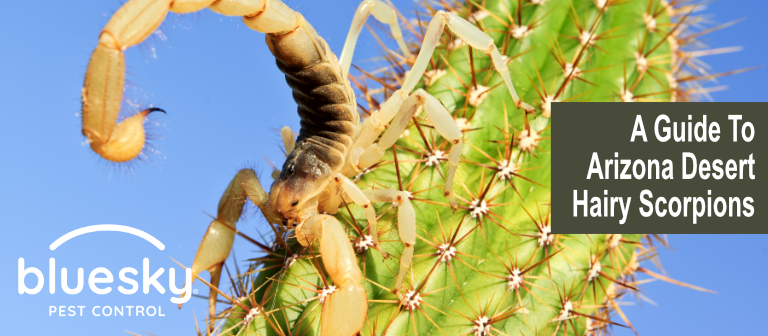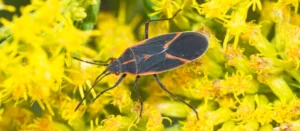$50 OFF New Residential Customers. Learn more
The Guide to Arizona Desert Hairy Scorpions: Are They Venomous?

A giant hairy scorpion…sounds like the thing of nightmares. The Arizona desert hairy scorpion, also known as the giant desert hairy scorpion, is actually more fascinating than scary. Found in the southwestern United States and Mexico, these scorpions have an impressive size and a distinctive ‘hairy’ appearance. While many have heard of these scorpions, there is often confusion about whether they are venomous or not. In this guide, we’ll take a closer look at the Arizona desert scorpion and explore the question of its venomosity. We’ll also provide tips for safely observing these [misunderstood] arachnids in their natural habitat. Interested in learning more about these desert dwellers…read on.
We perform scorpion control throughout the Phoenix area. We have offices in Phoenix and Gilbert and serve Mesa, Queen Creek, Scottsdale, and Peoria!
Arizona Desert Hairy Scorpion
The Arizona desert hairy scorpion, Hadrurus arizonensis, is a species of scorpion native to the southwestern United States and parts of Mexico. As its name suggests, this scorpion is known for its large size and distinctive hair appearance. Despite their intimidating appearance, Arizona desert hair scorpions are generally not considered to be dangerous to humans.
Like all scorpions, they do possess venom, but their venom is relatively mild, and not typically harmful to humans. That said, a sting from an Arizona desert hairy scorpion can still be quite painful, causing localized swelling and redness. This species of scorpion shows very little aggression toward people and are often kept as a terrarium pet. However, should you come across them in the wild, we do recommend handling them.
Arizona desert hairy scorpions are primarily nocturnal, being most active at night. During the day, they often seek shelter in burrows or other protected areas to avoid the hot desert sun. They are skilled predators, feeding on a variety of insects, spiders, and other small creatures. Despite their size, Arizona desert hairy scorpions are actually quite nimble and are capable of climbing walls and other vertical surfaces with ease.
Arizona Desert Hairy Scorpion vs Arizona Bark Scorpion
The Arizona desert hairy scorpion and the Arizona bark scorpion (Centruroides sculpteratus) are two common species found in the southwestern United States. While they may share some similarities, there are several key differences between these two species.
One of the most noticeable differences between the two is their size. The Arizona desert hairy scorpion is much larger than the Arizona bark scorpion, with adults typically growing up to seven inches in length. In contrast, the Arizona bark scorpion is much smaller, with adults typically reaching only two to three inches in length.
Another major difference between the two scorpions is their behavior. The Arizona desert hairy scorpion prefers to dig a deep burrow to hide in during the day, emerging at night to hunt, often by ambush. This large scorpion is solitary and will eat large insects, spiders, small lizards and snakes, and even other scorpions, including the Arizona bark scorpion and other Arizona giant hairy scorpions!
On the other hand, the Arizona bark scorpion will aggregate with members of its own species without eating them, and typically feeds on smaller prey like crickets.
Another difference between the two species is their habitat preferences. While both scorpions are found in desert regions, the Arizona desert hairy scorpion tends to prefer drier habitats such as sandy deserts and rocky areas. The bark scorpion, on the other hand, is commonly found in more moist areas such as canyons and riparian zones.
Perhaps the most important difference between the two species is their venom. While the venom of the Arizona desert hairy scorpion is relatively mild, the venom of the Arizona bark scorpion can be quite potent, even lethal in extreme cases. Arizona bark scorpion stings can cause a range of symptoms including pain, numbness, and difficulty breathing. They can be particularly dangerous for young children or individuals with compromised immune systems.
What Do They Look Like?
Arizona desert hairy scorpions are large, robust scorpions with a distinctive hairy appearance. They have two large pincers, eight legs, and a long, segmented tail that ends in a stinger. Their bodies are covered in tan or brown hair, which helps to protect them from the intense heat of their desert environment. Arizona desert hairy scorpions can range in color from light tan to dark brown, and grow to approximately 6 inches in length.
How Big Do They Get?
These unique-looking scorpions are among the largest scorpions in North America. Adult scorpions can range in size from 3 to 7 inches in length, with females generally being larger than males. The size of an Arizona desert hairy scorpion can vary depending on a variety of factors, including the availability of food, water, and shelter, as well as the climate and other environmental conditions. While these scorpions are generally larger than other species found in the same area, the size of individual scorpions can vary widely depending on their individual circumstances and age.
Are They Dangerous/Venomous?
Arizona desert hairy scorpions are venomous, but their venom is considered to be mild and is not normally dangerous to humans. While a sting from an Arizona desert hairy scorpion can be painful and cause localized swelling, most healthy adults will not experience any serious health effects. However, individuals who are allergic to scorpion venom or who have compromised immune systems may experience more severe reactions, and medical attention should be sought in these cases. It’s important to take precautions when encountering scorpions in the wild, but with proper care, the risk of serious injury from an Arizona desert hairy scorpion is relatively low.
Where do Arizona Desert Hairy Scorpions Live?
As mentioned previously, Arizona desert hairy scorpions are primarily found in the southwestern United States and northern Mexico. They inhabit a variety of desert habitats such as rocky areas, sandy deserts, and canyons. They are most commonly found in arid regions with hot, dry climates, but can also be found in more moderate climates such as grasslands and forests. Within their range, Arizona desert hairy scorpions can be found at elevations ranging from sea level to over 6,000 feet.
How To Get Rid of Arizona Hairy Desert Scorpions?
If Arizona desert hairy scorpions become a problem around your Arizona property, here are some general tips for managing scorpion populations in and around your home:
- Seal off all cracks and crevices in your home, including around doors, windows, and pipes, to prevent scorpions from entering.
- Keep your home free of clutter and debris, as scorpions may use these materials as hiding places.
- Use yellow outdoor lighting instead of white or blue lights, as scorpions are less attracted to yellow light.
- Remove any potential food sources for scorpions, such as insects or other small animals, from your property.
- If you do encounter a scorpion, use caution, and wear protective clothing. Use a long-handled object such as a broom to gently guide the scorpion into a container, and then release it into a safe area away from your home.
- Consider hiring a professional pest control company to assess your property and provide appropriate treatment options for managing scorpion populations.
How To Keep Them Out of Your Arizona Home?
Preventing Arizona desert hairy scorpions from returning to your home is essential for long-term management. Here are some steps you can take to minimize the chances of scorpions returning to your home:
- Seal all entry points: Scorpions can enter through very small cracks and gaps in your home. Check around doors and windows, plumbing pipes, electrical outlets, and other potential entry points. Seal any openings you find with caulk or weatherstripping.
- Keep your home clean: Scorpions are attracted to clutter and debris. Keep your home clean and free of clutter. This includes regularly vacuuming and sweeping, and removing piles of paper, clothes, and other items that can provide hiding places.
- Reduce moisture: Scorpions need moisture to survive. Fix any leaks and reduce humidity levels in your home. Use dehumidifiers in damp areas like basements and bathrooms.
- Remove outdoor hiding places: Remove rocks, woodpiles, and other debris from around your home. These provide hiding places for scorpions and make it easier for them to enter your home.
By taking these steps, you can help reduce the likelihood of scorpions returning to your home.
The Guide to Arizona Desert Hairy Scorpions Conclusion
In summary, should you be confronted with an infestation of Arizona desert hairy scorpions or any other pest in Arizona, the skilled experts at Blue Sky Pest Control are here to assist. Our high-character technicians utilize efficient and eco-friendly pest control techniques that prioritize the safety of you, your loved ones, and your pets. Our Blue Sky 365 program offers year-round protection, and peace of mind, from 52 common Arizona pests. Please don’t hesitate to reach out to obtain additional information about our services and how we can assist you in fortifying your home against unwelcome pests.
Related Posts

Killer Bees in Arizona? Understanding Africanized Bees and How to Coexist Safely
You’ve likely heard the term “killer bees” used to describe Africanized bees in Arizona, but did you know this nickname…

Red & Black Intruders: Meet Arizona’s Boxelder Bugs
Boxelder Bugs in Arizona If you’ve ever stepped outside and spotted a cluster of black-and-red bugs crawling on your porch…

Jumping Spiders in Arizona: Harmless or Hazardous?
Jumping spiders in Arizona might be small, but they can certainly give you a big surprise when they suddenly appear…